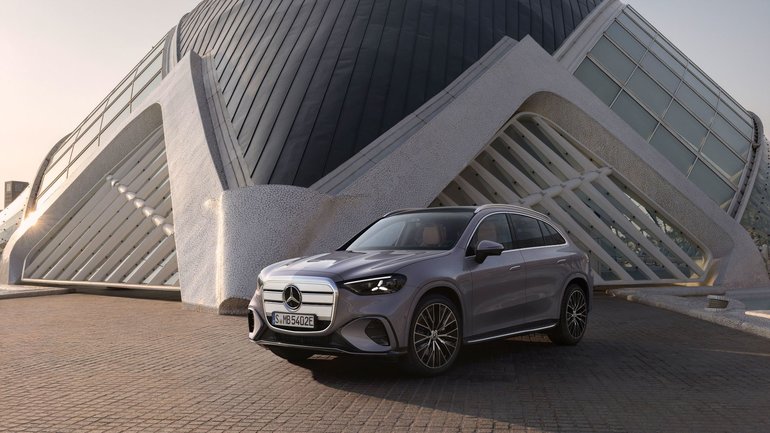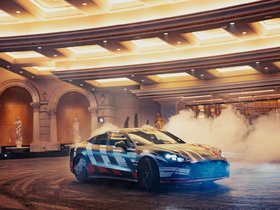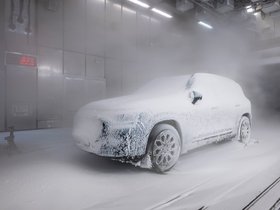Why Ottawa Drivers Are Considering the 2026 Mercedes-Benz GLC Electric SUV
October 28 2025,

The GLC has ranked as one of Mercedes-Benz's best-selling SUV models globally, and the upcoming 2026 GLC electric brings substantial changes to this familiar nameplate. For families and professionals throughout Ottawa and the National Capital Region, the transition to electric power maintains the GLC's core practicality while introducing battery-electric technology designed for daily use across Eastern Ontario.
The 2026 GLC electric will feature 800-volt fast-charging capability, dual-motor all-wheel-drive performance, and design elements adapted from Mercedes-Benz's S-Class flagship. These features address practical questions about electric vehicle usability during Canadian winters and longer regional trips.
Key Takeaways
|
Feature Category |
What the 2026 GLC Electric Offers |
|---|---|
|
Charging Technology |
800-volt architecture enables approximately 260 km of range in 10 minutes at compatible DC fast-charging stations |
|
Powertrain |
GLC 400 4MATIC delivers 349 hp through dual electric motors with variable all-wheel drive |
|
Winter Capability |
Multi-source heat pump standard, 4MATIC all-wheel drive with Disconnect Unit for efficiency |
|
Suspension |
Optional AIRMATIC air suspension adapted from S-Class, provides adaptive ride comfort |
|
Technology |
MB.OS operating system, optional MBUX Superscreen, Navigation with Electric Intelligence |
|
Interior Space |
Wheelbase extended 78.7 mm (3.1 inches) compared to current combustion GLC, improving rear legroom |
Fast-Charging for Regional Travel
The 800-volt electrical architecture enables DC fast-charging rates exceeding 320 kW at compatible stations. Under optimal conditions, the GLC electric can add approximately 260 km of range in 10 minutes. This charging speed addresses common concerns about charging time during trips between Ottawa and destinations like Gatineau Park, Kingston, or Montreal.
The battery management system includes intelligent preconditioning. When Navigation with Electric Intelligence is engaged, the system brings the battery to optimal temperature before arriving at a DC fast-charging station, ensuring peak charging performance without manual intervention.
Mercedes-Benz vehicles with CCS1 charging ports can access Tesla Supercharger stations across Canada through an approved adapter, expanding available fast-charging locations beyond the existing public charging network.
All-Wheel-Drive System for Ontario Winters
The GLC 400 4MATIC uses dual permanently excited synchronous motors producing 349 hp combined. The all-wheel-drive system distributes torque continuously between front and rear axles, adjusting power delivery based on available traction at each wheel.
The front-axle motor can be mechanically decoupled when not needed through a Disconnect Unit (DCU). During highway cruising or light-load situations, the front motor disengages to reduce parasitic losses by up to 90 percent. When road conditions require additional traction, the DCU re-engages the front motor within fractions of a second.
This variable torque distribution helps maintain stability during winter driving conditions throughout Ottawa and Eastern Ontario. The system continuously adapts to changing surface conditions without requiring driver input or mode selection.
AIRMATIC Suspension Technology
The optional Agility & Comfort Package includes AIRMATIC air suspension paired with rear-axle steering. This suspension technology comes from the Mercedes-Benz S-Class flagship sedan and provides adaptive damping that adjusts to road surface quality in real time.
The air suspension uses adjustable dampers that respond independently at each wheel during both compression and rebound stages. Sophisticated sensor technology and algorithms set the dampers according to road surface quality, preventing impacts at one wheel from transferring to the entire axle and interior.
The rear-axle steering offers up to 4.5 degrees of steering angle in each direction, improving maneuverability during parking and low-speed situations while enhancing stability during highway driving.
Interior Space and Practicality
The 2026 GLC electric features a wheelbase extended by 78.7 mm (3.1 inches) compared to the current combustion-engine GLC. This additional length contributes to increased headroom and legroom for both front and rear passengers.
The trunk provides a generous 20.1 cubic feet of cargo space, expandable to an impressive 61.4 cubic feet when rear seats fold down. Additionally, a front trunk (frunk) accessible via touch control adds 4.5 cubic feet of storage.
The extended wheelbase and electric vehicle architecture create a spacious cabin without reducing cargo capacity or requiring design compromises typical of retrofitted electric vehicles.
Multi-Source Heat Pump for Cold-Weather Operation
The GLC electric includes a standard air-side heat pump that uses approximately one-third of the energy required by a conventional auxiliary heater to deliver the same interior heating output. This multi-source system draws thermal energy from three sources simultaneously: waste heat from the electric drivetrain, waste heat from the battery, and ambient air.
The heat pump integrates into the climate control system and functions for both cooling in summer and heating in winter. During fast charging, the system maintains comfortable interior temperatures without compromising charging speed or efficiency.
This thermal management system preserves battery range during cold-weather operation common throughout Ontario winters, reducing the energy required for cabin heating while maintaining passenger comfort.
MB.OS and MBUX Technology
The 2026 GLC electric operates on Mercedes-Benz's new MB.OS operating system, controlling infotainment, driver assistance, body and comfort functions, and charging systems. The system enables over-the-air updates for vehicle functions, keeping software current without requiring service visits.
The optional MBUX Superscreen provides an expansive digital display spanning the dashboard. The interface features the MBUX Zero Layer, showing the most important information, recent apps, and personalized suggestions on the central display.
Navigation with Electric Intelligence plans optimal routes including necessary charging stops based on current battery state, traffic conditions, and charging station availability. The system automatically preconditions the battery before arriving at fast-charging stations to ensure peak charging performance.
Regenerative Braking and Energy Recovery
The GLC electric features a one-box brake system that combines regenerative and friction braking into a single coordinated system. The brake-by-wire design maintains consistent pedal feel regardless of whether deceleration occurs through regenerative braking or friction brakes.
Recuperation power reaches substantial levels, allowing the system to recover kinetic energy during most braking events and return it to the battery. The system can decelerate the vehicle entirely through regeneration in many situations, bringing the GLC to a complete stop without engaging friction brakes.
Drivers can adjust recuperation levels using paddles behind the steering wheel, allowing preference-based energy recovery during different driving situations.
Towing Capability and Payload
The GLC 400 4MATIC offers a towing capacity up to 2,400 kg (5,291 lbs) when properly equipped. The 99.8 kg (220 lb) tongue weight allows transport of electric bicycles and other gear on suitable carriers.
ESP trailer stabilization and trailer maneuvering assistant provide convenient and stable handling when towing. These systems work with the all-wheel-drive architecture to maintain control during trailer operation.
Learn More at Mercedes-Benz Ottawa Downtown
The 2026 Mercedes-Benz GLC electric will combine proven SUV practicality with battery-electric technology designed for daily use throughout the Ottawa region. Visit our team at Mercedes-Benz Ottawa Downtown in Ottawa to learn more about 800-volt charging technology, AIRMATIC suspension, and how the GLC electric addresses winter driving needs specific to Eastern Ontario.






